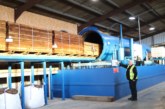
On April 15, the European Timber Trade Federation (ETTF) and the European Organization of the Sawmill Industry (EOS) organised a joint conference call which aimed to take stock of the effects of the Covid-19 crisis in the timber market and try to gauge what the situation will be in the coming months. Representatives from eleven European countries contributed to a lively discussion which enriched participants knowledge about the crisis and its impact.
Without doubt, the impact of the coronavirus outbreak is having wide-ranging and severe impacts upon the timber value chain. There are however significant differences among European countries: where the coronavirus has taken a heavier toll, the economy has been hardest hit. The construction sector, a fundamental market for the timber industry, has taken a hit in countries such as Spain, Italy, the United Kingdom and France, and also in businesses located elsewhere which are particularly exposed to this group of countries. In other parts of Europe, such as in Scandinavia, Germany, and the Netherlands, the local construction sector has been doing better. A crunch period might be on the cards also for these countries in Q3.
Sectors connected to logistics, such as pallets, are performing comparatively better than sectors connected to manufacturing, such as furniture industries. To meet struggling demand double-digit production curtailments have been introduced by mills, with reductions in Scandinavia comparatively milder than in Central Europe. It is expected that the Do It Yourself (DIY) sector will prop up the market as people spend more time at home, especially as DIY markets mostly remain open currently and hence are supporting sawmills and trade. Overall, it is likely that countries that are navigating this crisis with less casualties will turn more inward and direct their sales to their local market in the coming months.
For both EOS and ETTF members overseas markets are very important. Participants in the call stressed that China, as both fundamental client and producer, has been recovering in the last few weeks, while sales to the United States are dropping. The Indian market is completely closed, while there are difficulties in some South-East Asian countries. The shortage of container availability (and the increased prices of the latter) are still challenging, but the situation seems improving compared to a few weeks ago. Participants emphasized that the unhindered flow of raw materials and goods remain fundamental to ensure long-term viability of the industry. Both sawmillers and trade agreed that acting as a warehouse can buffer regional curtailments in supply and demand, an important function for general market stability and a functioning chain-of-custody. Some countries are also confronted with labour shortages. Provided health & safety standards are met, free circulation of labour must be ensured. At the same time, commercial credit insurers should not hinder the market with restrictive measures. Insurance companies (reinsurers) must continue to issue credit lines and not add oil to the fire by hampering cash-flow in an already turbulent market.
Looking forward, both organisations agreed that the length and intensity of the crisis will be crucial as to the pattern of recovery. If the coronavirus will be neutralised in the coming months, there is hope for a return to almost a business-as-usual situation – the timber sector in Q1 was doing well. Such a “V-shaped” outcome represents a best-case scenario. However, if the general economy and the construction sector remain subdued in Q3 and Q4, a prolonged contraction will take a heavy toll on the timber industry, even in countries that so far have managed to weather the storm. It seems very likely that the economy will undergo some structural changes reacting to the pandemic. The impact of these changes is for the moment not predictable but will likely be felt also in the timber industry.









